Fitting a sectional sofa into a small living space can seem daunting. But with the right pieces of furniture and creative seating arrangement ideas, even the tiniest of rooms can make room for a comfortable and stylish sectional sofa.
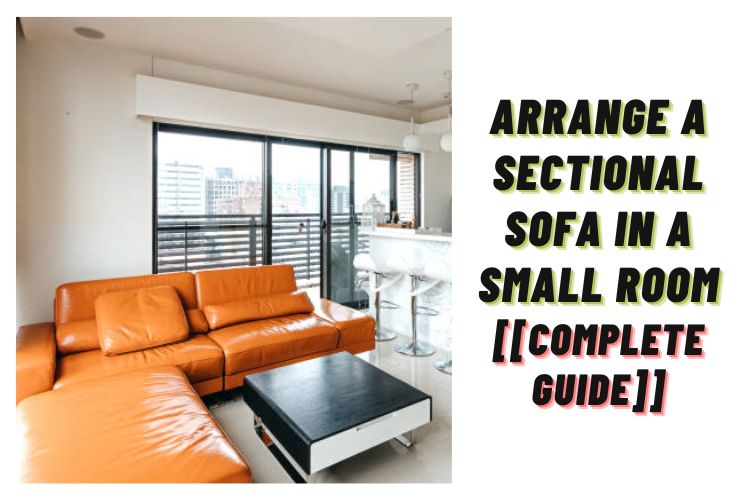
From studio apartments to traditional sofas and l-shaped couches, there are plenty of options for making the most out of your wall space, floor space, and natural light. Whether you’re looking for more seating options for overnight guests or just want to create a cozy spot to relax in, here are some great sectional layout ideas that will help make your small room look bigger.
Importance of sectional sofas in small rooms
Sectional sofas are a valuable furniture choice for small rooms due to their versatility and space-saving design. These sofas are designed to maximize seating capacity while minimizing the amount of floor space they occupy. Here are a few reasons why sectional sofas are important in small rooms.

1. It helps to optimize the available space in small rooms:
L-shaped, U-shaped, or curved design, sectional sofas can be customized to make the most of the limited space, providing ample seating options without overwhelming the room.
2. It offers additional functionality and storage options:
Many sectional sofas come with built-in storage compartments or ottomans that can be used to store blankets, pillows, or other items, helping to keep the room organized and clutter-free.
3. It can create a cozy and intimate seating area in small rooms:
By enclosing the seating area, these sofas can create a sense of privacy and comfort, making the space feel more inviting and relaxing.
4. It offers aesthetic benefits in small rooms:
They come in a wide range of designs, styles, and colors, allowing homeowners to choose one that complements their existing decor.
5. It can add visual appeal to a room:
Whether it’s a sleek and modern design or a traditional and classic style, sectional sofas can add visual appeal to the room, becoming a focal point or blending seamlessly with the overall aesthetic.
Note: The importance of sectional sofas in small rooms cannot be understated. They provide practicality, functionality, and style, making them an ideal choice for maximizing space and creating a comfortable and inviting living area.
Benefits of proper arrangement
A sectional sofa offers countless benefits beyond just providing comfortable seating. From maximizing space to enhancing the overall aesthetics of your room, the way you arrange your sectional can truly make a difference.

| Benefits | Explanation | How it works? |
| 1. Space optimization: | Properly arranging a sectional sofa in a small room allows for optimal utilization of space. | By positioning the sofa in a way that maximizes the available floor area, you can create a more open and spacious feel in the room. |
| 2. Increased seating capacity: | Sectional sofas typically have multiple sections that can be arranged in different configurations. | This versatility allows you to accommodate more seating options in a small room, making it easier to entertain guests or accommodate larger groups of people. |
| 3. Enhanced functionality: | The proper arrangement of a sectional sofa can provide additional functionality to a small room. | By placing the sofa against a wall or in a corner, you can create a cozy reading nook or a designated seating area for relaxation. |
| 4. Visual appeal: | A well-arranged sectional sofa can enhance the visual appeal of a small room. | By selecting a sectional sofa that complements the room’s decor and arranging it in a way that balances the space, you can create a cohesive and aesthetically pleasing look. |
| 5. Improved traffic flow: | In a small room, it’s essential to maintain a smooth traffic flow. | Properly arranging a sectional sofa ensures that there is enough space for people to move around comfortably without obstructing pathways or causing congestion. |
| 6. Versatile storage options: | Some sectional sofas come with built-in storage compartments or hidden compartments. | Properly arranging the sofa can make it easier to access and utilize these storage options, allowing you to keep the room organized and clutter-free. |
| 7. Flexibility for room layout changes: | The modular nature of sectional sofas allows for easy rearrangement when needed. | Whether you want to change the room’s layout for different purposes or simply refresh the aesthetic, a properly arranged sectional sofa offers the flexibility to adapt to your evolving needs. |
| 8. Comfort and relaxation: | By arranging a sectional sofa in a way that promoting comfort and relaxation, you can create a cozy and inviting atmosphere in a small room. | This can be achieved by selecting plush cushions, incorporating throw pillows, and positioning the sofa in a way that encourages relaxation and lounging. |
How to arrange a sectional sofa in a small living room?
Arranging a sectional sofa in a small living room can be challenging, but with the right placement and arrangement, you can maximize space and create a functional and visually appealing layout. Here are some tips on how to arrange a sectional sofa in a small living room:
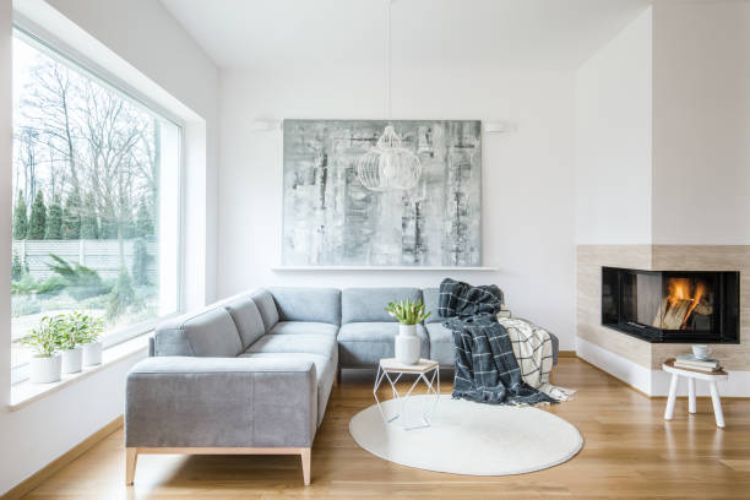
| Tips | Explanation |
| 1. Measure your space: | Before arranging the sectional sofa, measure the dimensions of your living room, including the length, width, and any architectural features or windows. This will help you determine the appropriate size and orientation for your sectional. |
| 2. Choose the right sectional: | Opt for a compact or apartment-sized sectional that fits well in a small living room. Consider a sectional with a chaise or one that can be separated into smaller pieces for more flexibility. |
| 3. Determine the focal point: | Identify the focal point of your living room, such as a fireplace, TV, or scenic window. Arrange the sectional to face the focal point to create a visually pleasing layout and make the most of your space. |
| 4. Create a cozy conversation area: | If your living room is small, consider placing the sectional against a wall to open up the space and create a cozy conversation area. Angle one end of the sectional towards the center of the room to encourage interaction. |
| 5. Use space-saving techniques: | Utilize space-saving techniques like floating the sectional away from the walls to create an illusion of more space. You can also place a small side table or ottoman in front of the sectional for added functionality without taking up too much room. |
| 6. Consider traffic flow: | Ensure that there is enough space for easy movement around the sectional. Leave clear pathways and avoid blocking doorways or creating obstacles that may disrupt the flow of the room. |
| 7. Add additional seating options: | If space allows, incorporate additional seating options like armchairs, stools, or ottomans to accommodate more guests without overcrowding the room. Opt for compact and easily movable pieces to maintain flexibility. |
| 8. Use visual tricks: | Use decorative elements such as mirrors, light-colored walls, and strategically placed lighting to create the illusion of a larger space. These visual tricks can help make your small living room feel more open and spacious. |
| 9. Consider storage solutions: | Look for sectional sofas with built-in storage compartments or utilize storage ottomans and shelves to maximize storage space in a small living room. This will help keep the room organized and clutter-free. |
| 10. Experiment and adjust: | Don’t be afraid to experiment with different arrangements and adjust as needed. Rearrange the sectional and other furniture pieces to find the layout that works best for your space and meets your functional and aesthetic needs. |
Note: Remember, the key is to maximize space, create a functional layout, and make the most of your sectional sofa in a small living room.
L-shape configuration
To place a sectional sofa in a small room in an L-shape configuration, follow these steps:

1. Measure the dimensions of your room to determine the available space for the sofa.
2. Place the longer section of the sectional sofa against one wall, positioning it parallel to the wall.
3. Position the shorter section of the sofa perpendicular to the longer section, creating an L-shape.
4. Ensure that there is enough space for comfortable movement around the sofa.
5. Consider placing a small coffee table or ottoman in front of the sofa, leaving enough space for walking and maneuvering in the room.
6. Arrange any additional furniture or decor items in a way that complements the L-shape configuration and maximizes space utilization.
7. Regularly reassess the placement of the sectional sofa to ensure it meets your needs and allows for optimal functionality in the small room.
U-shape configuration
To place a sectional sofa in a small room in a U-shape configuration, follow these steps:

1. Measure the dimensions of your room to determine the available space.
2. Choose a sectional sofa that fits within the dimensions of your room. Look for smaller-sized or apartment-sized sectional sofas.
3. Position one section of the sofa against a wall, leaving enough space for a walkway around it.
4. Place the second section perpendicular to the first section, creating an “L” shape.
5. Position the third section opposite the second section, completing the U-shape configuration.
6. Leave enough space between the sections for comfortable seating and movement.
7. Ensure there is enough clearance for opening doors and navigating around the sofa.
8. Arrange any additional furniture or decor in the remaining space, ensuring it complements the sectional sofa configuration.
9. Consider using space-saving techniques such as wall-mounted shelves or multipurpose furniture to maximize the functionality of the room.
10. Regularly assess the arrangement and make adjustments as needed to optimize the use of space and ensure comfort.
Symmetrical or asymmetrical arrangements
Follow the chart to know about symmetrical or asymmetrical arrangements. It actually depends on personal preferences. So follow the chart to make a smart decision.
| Symmetrical arrangement | Asymmetrical arrangement |
| 1. Place the sectional sofa against one wall, centered in the room. | 1. Place the sectional sofa at an angle in one corner of the room, creating a diagonal line. |
| 2. Place a small coffee table in front of the sofa, aligned with the center of the sofa. | 2. Position a floor lamp next to the sofa to provide additional lighting and balance the asymmetry. |
| 3. Add two matching accent chairs on either side of the sofa, creating a balanced and symmetrical seating arrangement. | 3. Place a small side table next to one end of the sofa, allowing for a convenient surface for drinks or books. |
| 4. Place a rug underneath the entire seating area to anchor the space and define the seating area. | 4. Add a single accent chair or a set of mismatched chairs on the opposite side of the sofa, creating an asymmetrical but visually interesting arrangement. |
Assessing the available space in your room
Assessing the available space in your room for a sectional sofa requires careful measurement and consideration of various factors. Here are some detailed steps to follow:
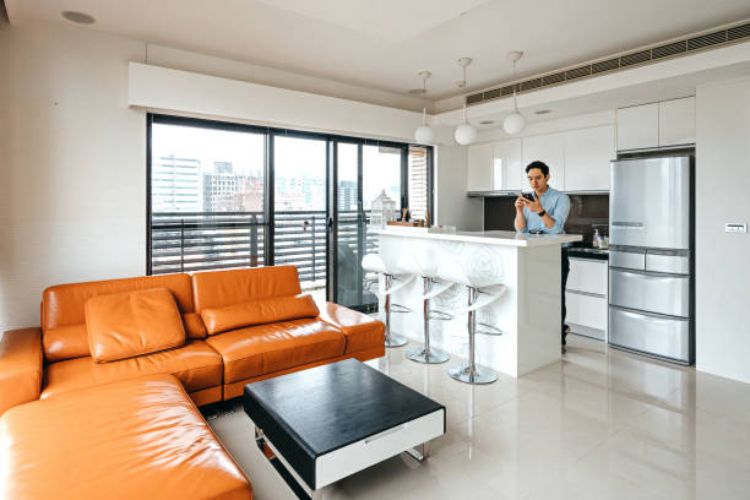
| Steps | Explanation |
| 1. Clear the area: | Begin by removing any furniture or obstacles in the room that may obstruct the measurement process or placement of the sectional sofa. |
| 2. Measure the length and width of the room: | Use a measuring tape to accurately measure the length and width of the room where the sectional sofa will be placed. Measure from wall to wall, ensuring that you capture the full dimensions of the space. |
| 3. Determine the desired placement of the sectional sofa: | Consider the optimal location for the sectional sofa within the room. Take into account factors such as natural light, traffic flow, and existing furniture arrangements. |
| 4. Measure the available wall space: | Measure the length of the wall or walls where the sectional sofa will be positioned. This will give you an idea of how much linear space is available for the sofa. |
| 5. Measure the depth and height of the sectional sofa: | Measure the depth and height of the sectional sofa itself. This will help you determine if the sofa will fit comfortably within the available space without obstructing walkways or other furniture. |
| 6. Consider additional features: | If the sectional sofa includes additional features such as recliners or a chaise lounge, take these into account when assessing the available space. Ensure that there is enough clearance for these features to fully extend and function properly. |
| 7. Account for doorways and passages: | Measure the width of doorways, hallways, and any other passages through which the sectional sofa needs to fit during delivery and assembly. This will help you determine if the sofa can be maneuvered into the room without any issues. |
| 8. Allow for ample space around the sectional sofa: | Consider leaving some space around the sectional sofa for easy movement and to avoid a cramped appearance. Aim for at least 2 to 3 feet of clearance on all sides. |
| 9. Create a visual representation: | Use graph paper or an online room planner tool to create a scaled-down floor plan for your room. This will allow you to visualize how the sectional sofa will fit within the space and help you determine if any adjustments are needed. |
| 10. Consult with a professional if needed: | If you are unsure about accurately measuring the available space or need assistance in determining the best sectional sofa size for your room, consider consulting with an interior designer or furniture specialist. They can provide expert guidance based on your specific room and requirements. |
Measuring the room dimensions
Measuring the room dimensions is essential for various purposes, such as planning furniture placement, determining square footage, or renovating the space. To measure the room first you will need some essential tools to start. They are listed below.
| Tools |
| 1. Tape measure |
| 2. Pencil |
| 3. Paper |
Below there are few simple steps, so you can accurately measure the dimensions of a room.
| Steps | Explanation |
| 1. Clear the space: | Remove any furniture or obstacles that might hinder your ability to measure the room accurately. Make sure the area is free from clutter and accessible from all sides. |
| 2. Choose a starting point: | Select a corner of the room as your starting point. This corner will serve as your reference point for measuring the length and width of the room. |
| 3. Measure the length: | Extend your tape measure from the starting point to the opposite wall. Ensure that the tape measure is straight and parallel to the wall. Take note of the measurement in feet or meters, depending on your preference. |
| 4. Measure the width: | Move to the adjacent wall from your starting point and repeat the process of measuring the length. Again, ensure the tape measure is straight and parallel to the wall. Record the width measurement. |
| 5. Check for irregularities: | In some cases, rooms may have irregular shapes or features, such as alcoves or bay windows. Measure these additional dimensions separately, making sure to record them accurately. |
| 6. Calculate the area: | To determine the area of the room, multiply the length measurement by the width measurement. |
| 7. Double-check your measurements: | To ensure accuracy, go back and measure the length and width again. It’s essential to have precise measurements before proceeding with any projects or plans based on the room dimensions. |
Identifying potential obstacles
Placing a sectional sofa in a room requires careful consideration of various factors to ensure a successful placement. While sectional sofas offer versatility and can be arranged in multiple configurations, there are potential obstacles that need to be taken into account.
This list aims to identify and provide detailed explanations of potential obstacles that may arise when placing a sectional sofa in a room.
| Potential Obstacles | Explanation |
| 1. Limited space: | One potential obstacle to placing a sectional sofa is having limited space in the room. Sectional sofas are usually larger and bulkier than regular sofas, so it may be difficult to find enough space to accommodate the size and shape of the sectional. |
| 2. Doorway size: | Another obstacle could be the size of the doorway or entryway leading to the room where the sectional sofa is intended to be placed. If the doorway is too narrow or has a low ceiling height, it may be challenging to maneuver and fit the sectional through the entrance. |
| 3. Stairs and tight corners: | If there are stairs or tight corners within the home, it may be challenging to navigate and carry the sectional sofa to the desired room. The size and shape of the sectional may not be easily maneuverable in these areas. |
| 4. Weight and handling: | Sectional sofas can be heavy and cumbersome to handle, especially if they have multiple pieces. If there are no additional hands available to help with lifting and moving, it can be a significant obstacle to properly placing the sectional. |
| 5. Existing furniture and layout: | The current furniture arrangement and layout of the room may pose obstacles to placing a sectional sofa. If there are already large pieces of furniture or other items occupying the space, it may be difficult to find a suitable spot for the sectional without sacrificing comfort or functionality. |
| 6. Structural limitations: | Structural limitations within the room, such as low ceilings, angled walls, or irregular floor plans, can make it challenging to find a suitable location for the sectional sofa. These limitations may restrict the positioning options and affect the overall visual appeal and functionality of the furniture placement. |
| 7. Budget constraints: | Budget constraints can be an obstacle when it comes to placing a sectional sofa. Sectionals can vary significantly in price, and finding one that fits within the desired budget while meeting the size and style requirements can be a challenge. |
| 8. Delivery and assembly: | If purchasing a sectional sofa from a furniture store, the delivery and assembly process can present obstacles. Issues such as scheduling conflicts, difficulty in maneuvering the sofa into the desired room, or challenges in assembling the sectional can hinder the placement process. |
| 9. Room layout and functionality: | The overall layout and functionality of the room may not be conducive to placing a sectional sofa. If the room has an unconventional shape, limited wall space, or specific design requirements, it may be difficult to find an arrangement that works well with the sectional. |
| 10. Personal preferences and style: | Personal preferences and style choices can also be obstacles to placing a sectional sofa. If the desired style or aesthetic of the sectional does not match the existing decor or the homeowner’s preferred design scheme, it may be challenging to incorporate the sectional seamlessly into the room. |
Considering traffic flow
When considering traffic flow to place a sectional sofa, it is important to optimize the layout in order to create a functional and efficient living space. The placement of a sectional sofa can greatly impact the flow of traffic within a room, so it is crucial to carefully consider its location.
By strategically positioning the sectional sofa, you can ensure that the traffic flow is as short and direct as possible, allowing for easy movement and a comfortable living environment.
Selecting the right sectional sofa for a small room
Selecting the right sectional sofa for a small room can be challenging, but with careful consideration, you can find a perfect fit. Here are some factors to consider:
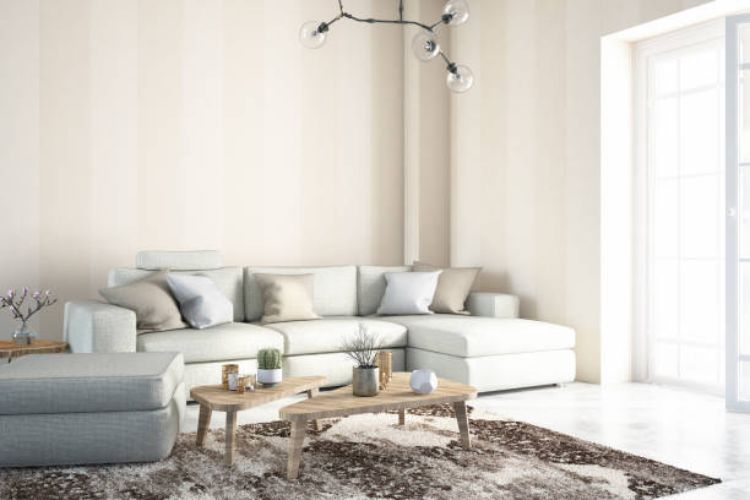
1. Size: Measure the dimensions of your room to determine the maximum size of the sectional sofa that will fit comfortably. Consider not only the length and width but also the height of the sofa.
2. Shape: Choose a sectional sofa with a compact shape that suits your room layout. Options include L-shaped, U-shaped, or even a chaise lounge style. Consider whether a reversible or modular design would be more suitable for your space.
3. Style: Look for a sectional sofa that matches the overall style and decor of your room. Consider the color, upholstery, and design elements such as tufting or sleek lines. Opt for lighter colors or neutral tones to create an illusion of a more spacious room.
4. Functionality: Consider the functionality you need from your sectional sofa. Some options may include built-in storage, pull-out beds, or reclining features. Choose features that will enhance the usability of your small space.
5. Comfort: Test the comfort of the sectional sofa before making a purchase. Sit on it, lie down, and check the cushioning and support. Ensure that it offers both comfort and the right level of firmness.
6. Configurability: If your space allows, consider a sectional sofa that can be rearranged or separated into individual pieces. This flexibility will allow you to adapt the sofa to different room layouts or create additional seating options when needed.
7. Traffic flow: Consider how the sectional sofa will affect the traffic flow in your room. Make sure it does not obstruct doorways, windows, or walking paths. Leave enough space for easy movement around the sofa.
8. Durability: Look for a sectional sofa made of high-quality materials that can withstand regular use. Consider factors such as the frame construction, upholstery fabric, and stitching. Opt for materials that are easy to clean and maintain.
9. Price: Set a budget for your sectional sofa and stick to it. Compare prices from different retailers and consider the overall value, taking into account factors such as quality, warranty, and customer reviews.
10. Delivery and assembly: Check if the sectional sofa can be easily delivered and assembled in your small room. Some modular designs or sofas with detachable parts may make the delivery and assembly process more manageable.
By considering these factors, you can find a sectional sofa that not only fits perfectly in your small room but also meets your comfort and style preferences.
Size and scale considerations
Considering the size and scale considerations of a sectional sofa when placing it in a small room is essential to optimize space utilization, ensure comfort and functionality, maintain visual appeal, promote safety, and provide flexibility for the room’s layout.
Configurations suitable for small rooms
Always consider the specific dimensions and layout of your room when configuring a sectional sofa. Experiment with different arrangements to find the best fit for your small space. Here are some ideas to consider when placing a sectional sofa in a small room.
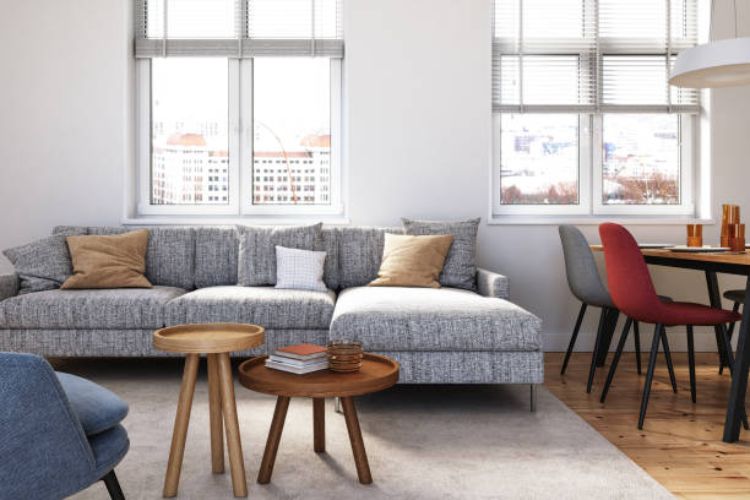
| Ideas | Explanation |
| 1. Measure the room: | Before purchasing a sectional sofa, measure the dimensions of the room to ensure it will fit properly. Consider the length, width, and height of the space to determine the size of the sofa that will work best. |
| 2. Choose a compact sectional sofa: | Look for a sectional sofa that is specifically designed for small spaces. Opt for a compact size that will fit comfortably without overpowering the room. Consider a sofa with a chaise lounge or a smaller sectional with a few seating options. |
| 3. Consider a reversible or modular sectional: | A reversible or modular sectional allows you to configure the sofa in different ways to fit your small room. This flexibility allows you to customize the shape and arrangement to suit your space and needs. |
| 4. Place the sectional against a wall: | To maximize floor space, place the sectional sofa against a wall. This helps to create an open layout and prevents the sofa from obstructing traffic flow in the room. |
| 5. Use corner placement: | If your room has a corner, consider placing the sectional sofa in that area. Corner placement helps to utilize the available space efficiently and can create a cozy seating area. |
| 6. Opt for a floating arrangement: | If space allows, consider floating the sectional sofa in the middle of the room. This can create a more open and spacious feel, giving the illusion of a larger area. However, ensure that there is still enough space for easy movement around the sofa. |
| 7. Use multifunctional furniture: | In a small room, it’s essential to make the most of every piece of furniture. Look for sectional sofas with built-in storage or ones that can be converted into a bed. This allows you to maximize functionality and save space. |
| 8. Consider the shape of the sectional: | L-shaped or U-shaped sectionals may not be suitable for small rooms as they can take up a significant amount of space. Instead, opt for a straight or curved sectional that can fit more easily into a compact area. |
| 9. Choose a light-colored or neutral fabric: | Light-colored or neutral fabric can help create an illusion of a larger space. Dark colors tend to make a room feel smaller, so opt for lighter shades to open up the room visually. |
| 10. Add accent chairs or ottomans: | If your room allows, consider adding accent chairs or ottomans to complement the sectional sofa. These additional seating options can provide extra seating without taking up too much space. Choose pieces that can be easily moved or tucked away when not in use. |
Optimal upholstery and colors for visual space optimization
When it comes to placing a sectional sofa in a small room, there are a few considerations to keep in mind for optimal upholstery and colors to visually optimize the space. Here are some suggestions:
1. Light-colored upholstery: Choose a sectional sofa with light-colored upholstery, such as pale beige, light gray, or soft pastel shades. Light colors help create an illusion of a larger space by reflecting more light and making the room feel more open and airy.
2. Minimal patterns: Opt for upholstery with minimal patterns or subtle textures. Large, bold patterns can visually overwhelm a small room and make it feel crowded. Stick to simple designs or solid colors to maintain a clean and uncluttered look.
3. Low-profile design: Look for a sectional sofa with a low backrest and slim arms. A low-profile design helps to visually open up the room as it takes up less visual space. Avoid bulky or oversized sofas that can make the room feel cramped.
4. Multifunctional features: Consider a sectional sofa with built-in storage or a pull-out bed. These features can help maximize space efficiency in a small room by providing additional storage or accommodating overnight guests without the need for extra furniture.
5. Leggy or raised design: Choose a sectional sofa with legs or a raised base. This design feature creates an illusion of space by allowing light to flow underneath the sofa, making the room feel more spacious.
6. Neutral color scheme: Stick to a neutral color scheme for the overall room decor. Use colors like white, beige, or light gray for the walls, curtains, and other furniture pieces. Neutral colors create a cohesive and harmonious look, making the room feel larger and more cohesive.
7. Mirror placement: Consider placing a mirror strategically across from the sectional sofa. Mirrors can reflect light and create an illusion of depth, making the room appear bigger and more open.
Note: Remember, the key is to keep the overall design simple, light, and uncluttered. By choosing the right upholstery and colors, you can visually optimize the space and create a cozy yet spacious feel in a small room.
Tips for enhancing the perception of space
Follow the below tips for enhancing the perception of space:
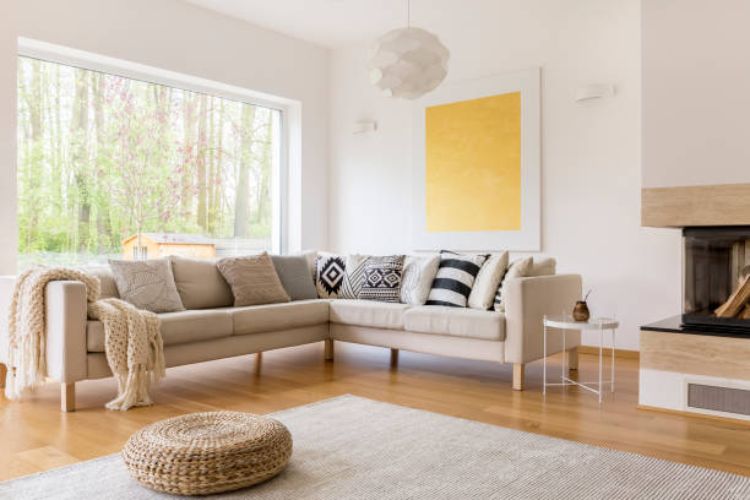
1. Use light colors on walls and furniture to create an illusion of openness.
2. Maximize natural light by using sheer curtains or blinds.
3. Remove unnecessary clutter to create a more spacious look.
4. Use mirrors strategically to reflect light and create a sense of depth.
5. Opt for furniture with legs to create an airy and open feel.
6. Choose multi-functional furniture to save space and reduce visual clutter.
7. Use vertical storage solutions to maximize floor space.
8. Keep the space well organized and tidy to create an open and spacious atmosphere.
9. Utilize wall-mounted shelves and floating furniture to free up floor space.
10. Incorporate large windows or glass doors to visually expand the space.
Conclusion
When arranging a sectional sofa in a small room, it is important to consider the layout and functionality of the space. Start by measuring the room and the dimensions of the sectional sofa to ensure a proper fit.
Then, consider the focal point of the room and position the sofa in a way that maximizes the use of space and allows for easy movement.
Consider placing the sectional against a wall or in a corner to open up the room and create a sense of openness. Using modular or compact sectional pieces can provide more flexibility and allow for easy rearrangement as needed.
FAQs
Frequently Asked Questions
What are the rules of thumb for arranging a sectional sofa?
The rules of thumb for arranging a sectional sofa include considering the size and shape of the room, determining the focal point, leaving enough space for traffic flow, and ensuring that the seating arrangement promotes conversation and comfort.
Are there any rules of thumb for arranging a sectional in a small room?
Yes, there are a few rules of thumb for arranging a sectional in a small room. Firstly, consider the size and shape of the room. It’s important to choose a sectional that fits well within the space without overwhelming it. Opt for a smaller or modular sectional that can be easily rearranged to suit different layouts. Secondly, think about the flow and functionality of the room.
Arrange the sectional in a way that allows for easy movement and access to other furniture or areas of the room. Avoid blocking doorways or walkways. Lastly, consider the visual balance and aesthetics of the room. Place the sectional in a way that creates a focal point and complements the overall style and décor of the room.
What are the common mistakes to avoid when arranging a sectional sofa?
The common mistakes to avoid when arranging a sectional sofa include not measuring the space properly, not considering the flow of the room, choosing the wrong size or shape of the sectional, and not considering the functionality and comfort of the seating arrangement. It is important to carefully plan and consider these factors to ensure a well-arranged and functional sectional sofa.

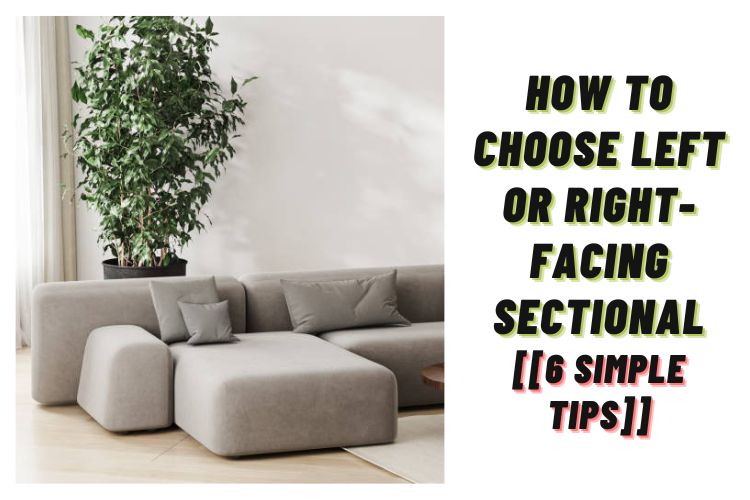
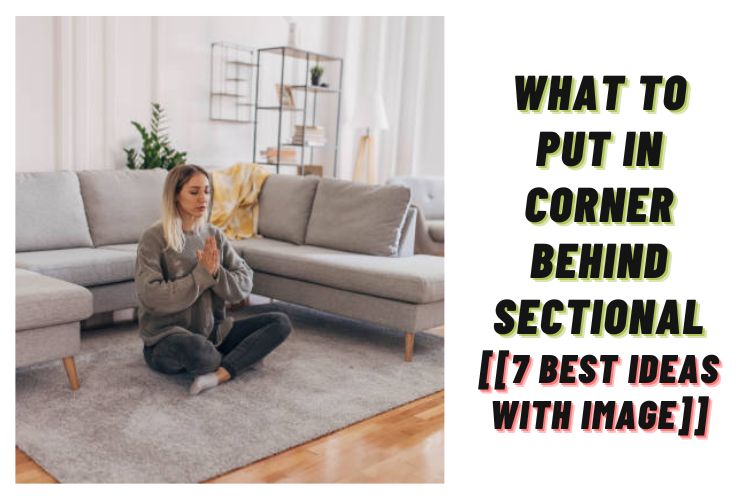
Leave a Reply